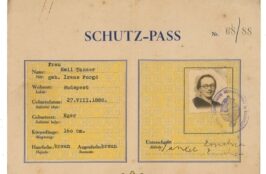During the nine-month period prior to his arrest, Raoul Wallenberg was responsible for orchestrating one of the most courageous and imaginative feats of rescue in the history of mankind.
On March 14, 1944, the Nazis invade Hungary. The local government turns over the Hungarian Jews in the countryside to the Germans. As a result, some 450,000 Jews are deported and most of them die in the Nazi death camps.
Hitler decided to dispatch Eichmann to ensure that the remainder of the Hungarian Jewry – some 200,000 souls, most of them in Budapest, meet the same fate.
At this stage, the Swedish and other neutral legations, issue provisional passports, but these efforts need to be stepped-up and combined with other rescue measures.
Feverish negotiations between the Swedish Foreign Ministry, the American War Refugee Board and the World Jewish Congress, end-up resolving the appointment of a Swede that would be responsible to lead the rescue mission. Raoul Wallenberg is recommended by his business associate, Kalman Lauer, “as the right man in the right place”, and on July 9, 1944, Raoul arrives in Budapest and is appointed Secretary of the Swedish Legation.
He immediately launches a well-organized rescue operation which includes the issue of “protective documents” (Schutzpasses) and establishes a network of Swedish safe houses, with the aid of more than 300 volunteers. Being aware of the German mentality, Wallenberg makes sure that his Schutzpasses are carefully crafted with symbols, stamps and colors, to make a strong impression.
At the age of 32, this scion of one of the most powerful and influential families in Sweden manages to orchestrate a magnificent rescue operation that saves the lives of tens of thousands of Hungarian Jews.
In January 1945, as it became clear that the Soviets would take over Hungary, Wallenberg was determined to guarantee the safety of the surviving Jewish community under the new rulers and decided to make a trip to Debrecen to meet Marshal Rodion Yakovlevich Malinovsky, commander of the Soviet forces in the region. Together with his trusted chauffer, Vilmos Langfelder, he departed from Budapest to Debrecen but instead of meeting Marshall Malinovsky, the two were intercepted by the MERSH and sent to Moscow for interrogation. From that moment on, the tracks of both Wallenberg and Langfelder faded from the face of the Earth.
Why was Wallenberg abducted by the Soviets? Historians are debating on this but the main reason might be related to Stalin’s’ paranoia. Wallenberg was originally recruited for his rescue mission by Iver Olsen, a US spy who worked at that time for the OSS, the forerunner of the CIA. Apparently, the Soviets could not believe that Wallenberg was purely moved by humanitarian reasons and thought he was an American agent.
Furthermore, his influential family back in Sweden had profited from the war, having made juicy supplies deals with both the Allies and the Nazis, adding to the Soviet paranoia. The role played by the powerful Wallenberg concern during WWII and its aftermath is depicted by Cees Wiebes and Gerald Aalders in their book – “The Art of Cloaking – the Case of Swedish Ownership”. According to these Dutch authors, the Wallenberg Bank Enskilda allegedly acted as a cloak for major German companies, helping them to avoid American confiscation. The Soviets might have been aware of these dealings and might have wanted to use Raoul as a bargaining chip against his powerful relatives.
Regrettably, the Swedish government and the highly influential Wallenberg family back home did almost nothing to set Raoul free.
Before the turn of the century, I had the great privilege of establishing the International Raoul Wallenberg Foundation, together with my dear late friend, Holocaust survivor and former Congressman, Tom Lantos. Ever since, our NGO has worked relentlessly to preserve and divulge the courageous legacy of the Swedish hero and to strive to secure reliable answers about his fate and whereabouts.
Back in 1985, US Ambassador to the UN, the late Jeane Kirpatrick, speaking on the 40th anniversary of Wallenberg’s abduction, stated: “Wallenberg has become more than a man, more even than a hero. He symbolizes a central conflict of our age, which is the determination to remain human and caring and free in the face of tyranny. What Raoul Wallenberg represented in Budapest was nothing less than the conscience of the civilized world.”
I feel Ambassador Kirpatrick was right. Raoul Wallenberg will forever be remembered as a symbol of humanity, courage and compassion.



